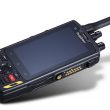News Briefs – Wednesday, March 22, 2006
Two-way radio retrofitted to include encryption modules
Kenwood U.S.A. has completed intrinsically safe testing of Transcrypt International’s encryption modules. Radios equipped with Transcrypt encryption are required to pass Kenwood’s intrinsically safe inspection, logging and certification labeling, according to a joint-company press release.
Kenwood’s conventional and LTR VHF/UHF portable two-way radios can now be fitted with Transcrypt encryption to provide secure communications in high-risk industrial and petro-chemical environments. The encryption technology will be available for TK-2180/3180, TK-2170/3170/3173, TK-290/390, TK-280/380 and TK-480/481 portable radios.
Real-time security enforcement tool fits wired and wireless communication devices
Mobile Armor released MobileSentinel, a security compliance and remediation solution for real-time, transparent, security policy enforcement on wired and wireless desktop, laptop and PDA devices. It ensures security through network-policy delivery, compliance enforcement, detailed auditing and automated remediation, said the company.
MobileSentinel offers cross-platform centralized management and reporting; data protection through high-speed encryption and integrated authentication; protection against malicious software; compliance and remediation; network protection from outside intruders; and the ability to establish a secure connection between mobile devices and networks.
Onboard technology provides wireless, wide-area access to data
In Motion Technology’s onBoard Mobile Gateway 1000 (oMG 1000) has been selected by the Mecklenburg Emergency Medical Services Agency (Medic) for deployment in 60 county vehicles. Medic has installed the units in its EMS vehicles to run the Mobile Area Routing and Vehicle Location System (MARVLIS) from Bradshaw Consulting Services and the electronic, patient-care record software from Medusa Medical Technologies, said the company.
The oMG 1000 provides wireless, wide-area access to mission-critical data by handheld devices in the vehicle, such as laptops and PDAs. It is designed for use in harsh, mobile and portable environments.
DRS Technologies lands $22 million U.S. government contract
DRS Technologies received $22 million worth of orders from U.S. intelligence and government agencies, as well as domestic and international defense prime contractors, to provide intelligence equipment for use in communications intelligence (COMINT) and signal intelligence (SIGINT) data. These products will be used in portable, fixed-site and mobile applications that support the intelligence community.
DRS will provide tuners, receivers, demodulators, modems, signal processors and direction-finding equipment. The equipment performs signal intercept—including cellular intercept, identification, direction finding, location and analysis functions—within the 5 kHz to 26+ GHz frequency spectrum range. It can be deployed on surveillance aircraft, helicopters, surface and subsurface vessels and vehicles, as well as at fixed sites, according to DRS.
Hazardous materials detectors pass DHS scrutiny
Ahura Corp.’s FirstDefender is now listed on the Responder Knowledge Base (RKB), a U.S. Department of Homeland Security-funded website designed to support the emergency-response community. The FirstDefender uses infrared detection technology to detect unknown solids and liquids. It is designed to meet military requirements and is optimized to meet the needs of civilian first responders, including those working with forensics, narcotics and hazardous materials, said the company.
The product has also been linked to the Standardized Equipment List (SEL), which was provided to the first-responder community by the InterAgency Board for Equipment Standardization and Interoperability (IAB). The SEL contains a list of IAB-recommended equipment for local, state and federal government organizations in preparation for—and response to—terrorist incidents and weapons-of-mass-destruction (WMD) events.












